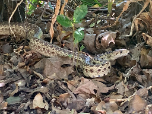Pacific Gopher Snake (Pituophis catenifer catenifer)
Description: Pacific gopher snake adults range in size from 3–7 feet in total length. However, most of the subspecies reach a length of 4–5 feet. The hatchlings are relatively long, and they have been recorded at lengths upward of 20 inches.
The Pacific gopher snake has a base color ranging from yellow to dark brown and has a gray coloring on the sides of the body. It is a spotted snake, with the spots being dark brown. Usually there are 41 to 99 spots on the body, while the tail spots range from 14 to 33. The side of the body has 2 or 3 rows of alternating black and brown spots.
A snake with keeled scales, and a narrow head that is wider than the neck, the Pacific gopher snake also displays a protruding rostral scale on the tip of the snout. The two most common base colors are straw and straw gray, though the species' color varies widely. The dorsal blotches, or saddles, are well-defined and generally dark to chocolate brown, though some specimens have had black blotches. The side blotches are often brown or gray. The back of the neck is dark brown. In many areas, such as Solano County, California, the snake can be found in a striped morph. The ventral side may be cream-colored to yellowish with dark spots. On the dorsal side, especially near the tail, there is often a reddish coloration.
Habitat: Found in a variety of habitats -open grassland and brushland, mixed woodlands, coniferous forest, agricultural farmland, chaparral, marshes, around suburban homes and garden sheds, and and riparian zones, from lowlands to the mountains.
Range: The Pacific gopher snake ranges up and down the West Coast of the United States,its range ending in the southern coast of California. Gopher snakes are rarely seen above 2,000 feet and are most commonly seen adjacent to farms in semi-arid brushy areas. The Pacific gopher snake can also be found in southern British Columbia and Alberta, and in Mexico.
Found in these States:
CA |
NV |
OR |
WA
Diet: Their diet consists of small mammals, notably pocket gophers; birds and their eggs; the occasional lizard and insect, and even bats.
Reproduction: Mating occurs in spring after emergence from winter hibernation. Mating and egg laying will occur later in more northern climates or at higher elevations. Females are oviparous, laying one to 2 clutches of 2-24 eggs from June - August. Eggs hatch in 2 - 2.5 months.
Status: Listed as Least Concern in view of the large and relatively stable extent of occurrence, area of occupancy, number of subpopulations, and population size. No major threats exist.
»» Kingdom: Animalia - Animals
»» Phylum: Chordata - Chordates
»» Subphylum: Vertebrata - Vertebrates
»» Class: Reptilia - Reptiles
»» Order: Squamata - Scaled Reptiles
»» Suborder: Serpentes
»» Superfamily: Colubroidea
»» Family: Colubridae - Colubrids
»» Genus: Pituophis
»» Species: Pituophis catenifer - Gopher Snakes
»» Subspecies: Pituophis catenifer catenifer - Pacific Gopher Snake
This article uses material from the Wikipedia article "Pacific Gopher Snake", which is released under the Creative Commons Attribution-Share-Alike License 3.0. Content may have been omitted from the original, but no content has been changed or extended.
|








